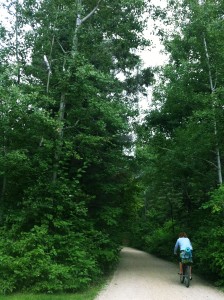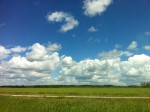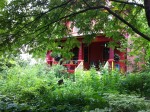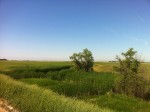A Placemaking Journal
Green Cities: Breathe deeply and walk freely
 As much as I love my winter city, when spring rolls around life brightens up. The onslaught of studies from Friday’s Earth Day imply that our feel-good response to the fresh lime green of spring does much more than pump endorphins. How we green our cities may be a life and death issue. People with greenery close to home have significantly lower mortality rates, according to new analysis of the extensive Nurses’ Health Study.
As much as I love my winter city, when spring rolls around life brightens up. The onslaught of studies from Friday’s Earth Day imply that our feel-good response to the fresh lime green of spring does much more than pump endorphins. How we green our cities may be a life and death issue. People with greenery close to home have significantly lower mortality rates, according to new analysis of the extensive Nurses’ Health Study.
If you’re a frequent PlaceShakers reader, you’ve heard us tout biophilia – or the love of living systems – particularly where nature has been integrated into urbanism. We’ve looked at how land use and transportation choice impact the earth. We’ve blogged about compact development patterns as a tool for rural preservation. We’ve explored the rapid change for the Inuit living on the land, where they’ve gone “from igloos to internet” in 40 years. And on Huffington Post, PlaceMakers’ Kaid Benfield is an advocate for the landscape, weaving preservation into development policy and nature into neighbourhoods.

Try calculating the neural impact of cycling to yoga in the car-free Rural Municipality of Victoria Beach, Manitoba.
Before updating these lines of thought with the latest on the measures quantifying why it all matters, I was contemplating some of the bio-electromagnetic basics of life. (Geek alert: only my fellow engineers may care about this next bit.) Before I became an urbanist, my field of study was bio-electromagnetics, or the body electric. We like to think of ourselves as chemical and mechanical organisms, without getting how energetic we really are. Bioelectromagnetism looks at the subtle – and not so subtle – energies that regulate living organisms.
This includes the neural communications within your nervous system, the electromagnetic field across your heart that keeps it beating, electric pulses that contract and release muscles, and even the way that the charge across your cell walls changes to take in nutrients and discard waste. Earth, too, is governed by electromagnetics that keeps the poles guiding migratory animals, and ourselves in ways we don’t pay attention to, and certainly can’t quantify. But it helps us “get our bearings.”
The earth and sky act as two infinite plates of a large capacitor, and when the electromagnetic differential builds up to the breakdown voltage of air, thunderstorms help discharge the negative ions back into the earth. So when spring calls you outdoors to plunge your hands into some soil at your community garden or in your back yard, it isn’t just because you have cabin fever after a long winter, it’s also because your body needs those ions.
However, outside of these subtle energies, there are many aspects of nature’s healing and recharging abilities that we can measure.
- Manitoba farmland and rangeland is preserved the more we change by-laws to cluster development. We have a ways to go.
- My favourite garden in my neighbourhood almost overtakes the dwelling.
- Even my dog is an avid gardener. Much to my dismay.
- Meditation comes easy on the shores of Lake Winnipeg.
- A worker village form-based code in the 20,000-acre CentrePort Canada helps to cluster development and preserve the landscape.
The ability of greenness to decrease mortality is thanks to better mental health through decreased depression risk and increased social engagement. Additionally, greenness reduces cancer, respiratory, and kidney-disease mortality due to less air pollution exposure and more physical activity. That’s according to a study released April 14, Exposure to Greenness and Mortality in a Nationwide Prospective Cohort Study of Women.
Week before last, Richard Louv published Vitamin N, following up on ideas from Last Child in the Woods. He encourages us to not get too formalized, but let the ideas of nature-rich communities be contagious, “What we need most is self-replicating cultural change,” that doesn’t wait for funding or permission.
University of Washington finds larger trees in yards plus street trees can add up to 15% to home values. Homes adjacent to naturalistic parks and open spaces are valued up to 20% higher. U.S. trees assimilate 784,000 tons of pollution annually, providing $3.8 billion in value, according to the US EPA, via American Society of Landscape Architects.
i-Tree formalizes the valuation of street trees, and recently found trees provide Austin, Texas annual savings of $19 million in building-energy use, $5 million in carbon emissions, $3 million in respiratory health savings from less air pollution, and $12 million in carbon sequestration. That’s $39 million in annual savings. Plus they’re worth $16 billion as a standalone physical asset. Nothing to shake a stick at.
Having worked in the Portland metro area last year, and looking forward to going back in the autumn, this piece on how the city incorporates nature is inspiring. Street trees in Portland increase annual property tax revenues by as much as $15 million.
In Toronto, ten or more trees in a city block improved how people rate their health by being seven years younger or a level comparable to an increase in annual personal income of $10,000.
Watch for a post soon by PlaceMakers’ Kaid Benfield preparing for his Urbanism & Sustainability lecture at CNU24 in Detroit in June. Kaid is the author of People Habitat: 25 Ways to Think About Greener, Healthier Cities, and takes a holistic approach to planning resilient communities — ecologically and socially. Until then, early spring bookended by Earth Day and Arbour Day provides all sorts of reflection on why we should embrace the oxygen-pumping goodness of flora.
All photos credit Hazel Borys, CreativeCommons ShareAlike License, with attribution. Click or control-click to view large.
If PlaceShakers is our soapbox, our Facebook page is where we step down, grab a drink and enjoy a little conversation. Looking for a heads-up on the latest community-building news and perspective from around the web? Click through and “Like” us and we’ll keep you in the loop.







